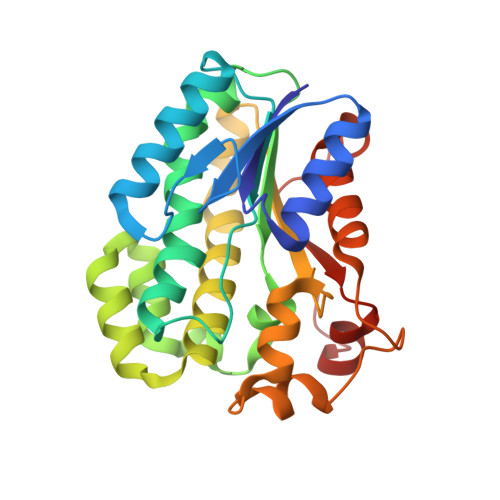Apo- and Holo-structures of 3{alpha}-Hydroxysteroid Dehydrogenase from Pseudomonas sp. B-0831: LOOP-HELIX TRANSITION INDUCED BY COENZYME BINDING
Nakamura, S., Oda, M., Kataoka, S., Ueda, S., Uchiyama, S., Yoshida, T., Kobayashi, Y., Ohkubo, T.(2006) J Biological Chem 281: 31876-31884
- PubMed: 16905772
- DOI: https://doi.org/10.1074/jbc.M604226200
- Primary Citation of Related Structures:
2DKN - PubMed Abstract:
Bacterial 3alpha-hydroxysteroid dehydrogenase, which belongs to a short-chain dehydrogenase/reductase family and forms a dimer composed of two 26-kDa subunits, catalyzes the oxidoreduction of hydroxysteroids in a coenzyme-dependent manner. This enzyme also catalyzes the oxidoreduction of nonsteroid compounds that play an important role in xenobiotic metabolism of bacteria. We performed an x-ray analysis on the crystal of Ps3alphaHSD, the enzyme from Pseudomonas sp. B-0831 complexed with NADH. The resulting crystal structure at 1.8A resolution showed that Ps3alphaHSD exists as a structural heterodimer composed of apo- and holo-subunits. A distinct structural difference between them was found in the 185-207-amino acid region, where the structure in the apo-subunit is disordered whereas that in the holo-subunit consists of two alpha-helices. This fact proved that the NADH binding allows the helical structures to form the substrate binding pocket even in the absence of the substrate, although the region corresponds to the so-called "substrate-binding loop." The induction of alpha-helices in solution by the coenzyme binding was also confirmed by the CD experiment. In addition, the CD experiment revealed that the helix-inducing ability of NADH is stronger than that of NAD. We discuss the negative cooperativity for the coenzyme binding, which is caused by the effect of the structural change transferred between the subunits of the heterodimer.
- Graduate School of Pharmaceutical Sciences, Osaka University, 1-6 Yamadaoka, Suita, Osaka 565-0871, Japan.
Organizational Affiliation:

















